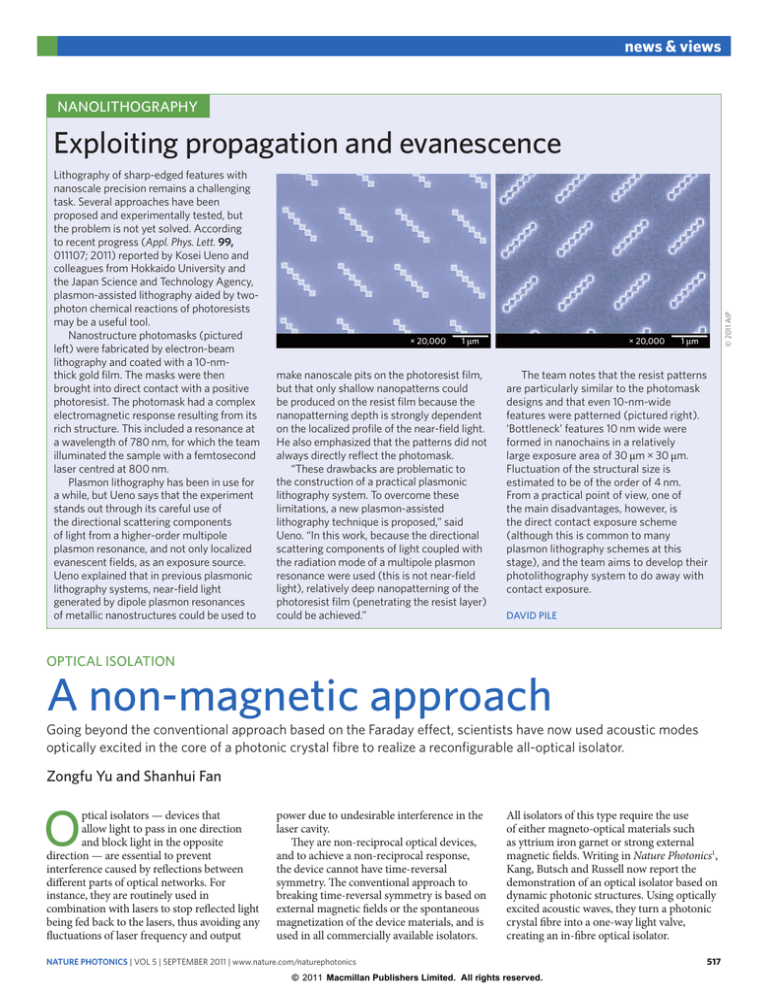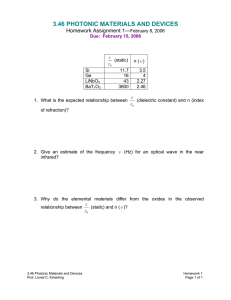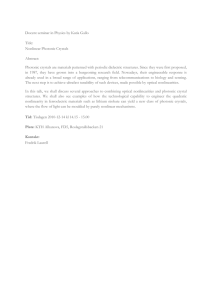Optical isolation: A non-magnetic approach
advertisement

news & views Nanolithography Lithography of sharp-edged features with nanoscale precision remains a challenging task. Several approaches have been proposed and experimentally tested, but the problem is not yet solved. According to recent progress (Appl. Phys. Lett. 99, 011107; 2011) reported by Kosei Ueno and colleagues from Hokkaido University and the Japan Science and Technology Agency, plasmon-assisted lithography aided by twophoton chemical reactions of photoresists may be a useful tool. Nanostructure photomasks (pictured left) were fabricated by electron-beam lithography and coated with a 10-nmthick gold film. The masks were then brought into direct contact with a positive photoresist. The photomask had a complex electromagnetic response resulting from its rich structure. This included a resonance at a wavelength of 780 nm, for which the team illuminated the sample with a femtosecond laser centred at 800 nm. Plasmon lithography has been in use for a while, but Ueno says that the experiment stands out through its careful use of the directional scattering components of light from a higher-order multipole plasmon resonance, and not only localized evanescent fields, as an exposure source. Ueno explained that in previous plasmonic lithography systems, near-field light generated by dipole plasmon resonances of metallic nanostructures could be used to × 20,000 1 µm make nanoscale pits on the photoresist film, but that only shallow nanopatterns could be produced on the resist film because the nanopatterning depth is strongly dependent on the localized profile of the near-field light. He also emphasized that the patterns did not always directly reflect the photomask. “These drawbacks are problematic to the construction of a practical plasmonic lithography system. To overcome these limitations, a new plasmon-assisted lithography technique is proposed,” said Ueno. “In this work, because the directional scattering components of light coupled with the radiation mode of a multipole plasmon resonance were used (this is not near-field light), relatively deep nanopatterning of the photoresist film (penetrating the resist layer) could be achieved.” × 20,000 © 2011 AIP Exploiting propagation and evanescence 1 µm The team notes that the resist patterns are particularly similar to the photomask designs and that even 10-nm-wide features were patterned (pictured right). ‘Bottleneck’ features 10 nm wide were formed in nanochains in a relatively large exposure area of 30 μm × 30 μm. Fluctuation of the structural size is estimated to be of the order of 4 nm. From a practical point of view, one of the main disadvantages, however, is the direct contact exposure scheme (although this is common to many plasmon lithography schemes at this stage), and the team aims to develop their photolithography system to do away with contact exposure. David Pile Optical isolation A non-magnetic approach Going beyond the conventional approach based on the Faraday effect, scientists have now used acoustic modes optically excited in the core of a photonic crystal fibre to realize a reconfigurable all-optical isolator. Zongfu Yu and Shanhui Fan O ptical isolators — devices that allow light to pass in one direction and block light in the opposite direction — are essential to prevent interference caused by reflections between different parts of optical networks. For instance, they are routinely used in combination with lasers to stop reflected light being fed back to the lasers, thus avoiding any fluctuations of laser frequency and output power due to undesirable interference in the laser cavity. They are non-reciprocal optical devices, and to achieve a non-reciprocal response, the device cannot have time-reversal symmetry. The conventional approach to breaking time-reversal symmetry is based on external magnetic fields or the spontaneous magnetization of the device materials, and is used in all commercially available isolators. All isolators of this type require the use of either magneto-optical materials such as yttrium iron garnet or strong external magnetic fields. Writing in Nature Photonics1, Kang, Butsch and Russell now report the demonstration of an optical isolator based on dynamic photonic structures. Using optically excited acoustic waves, they turn a photonic crystal fibre into a one-way light valve, creating an in-fibre optical isolator. nature photonics | VOL 5 | SEPTEMBER 2011 | www.nature.com/naturephotonics © 2011 Macmillan Publishers Limited. All rights reserved. 517 news & views 518 a y x z Frequency A typical magnetic isolator consists of a polarization filter and a Faraday rotator (Fig. 1a). Incident light in the forwards direction is linearly polarized in the y direction after passing through the polarization filter (not shown in Fig. 1a). The magneto-optical effect in the Faraday rotator causes the polarization direction of the incident light to rotate by 45°. When this light is reflected by some subsequent interface and propagates in the backwards direction, the reflected light has its polarization rotated by another 45° after again passing through the Faraday isolator. Instead of returning to the y polarization, the backwards light is now polarized in x direction, and is thus blocked by the polarization filter. The isolator experimentally demonstrated by Kang et al. is non-magnetic1 and is closely related to a recent theoretical proposal of a complementary metal–oxide–semiconductor (CMOS)-compatible isolation scheme2. In ref. 2, the non-reciprocity arises from a dynamic refractive-index modulation, which creates an interband photonic transition. It is essentially a waveguide that supports two photonic bands (Fig. 1b). A travellingwave modulation (Fig. 1b, green arrow) is introduced to provide phase-matched coupling between two modes, each of which is in one of these two bands in the forwards direction. Such modulation causes a photonic transition between the two modes in the forwards direction. However, there is no transition in the backwards direction because the modulation does not satisfy the phasematching condition for any pair of modes in that direction. The modulation therefore creates strong non-reciprocity. With proper design, such non-reciprocity can be used to create an isolator with response functions that are indistinguishable from the standard magneto-optical isolators. The theoretical scheme of ref. 2 requires an external modulation of the photonic structure. Kang et al.1 take an important further step and come up with a very clever way to generate the modulation. To create non-reciprocity for a signal light beam, they send a control light beam in the forwards direction into the same photonic crystal fibre (Fig. 1c). When the control light copropagates with the signal light, the control light beats with the signal light to generate a unidirectional acoustic wave. For a choice of signal and control light beams in the two different photonic bands, the generated acoustic wave automatically satisfies the phase-matching condition required for interband transition in the forwards direction. Specifically, the control and signal light beams are sent into a 15-m-long photonic crystal fibre with a core diameter of 1.8 μm. Both beams are single-frequency waves b Second band f0 − fAR First band f0 Wave vector c f0 − fAR f0 Figure 1 | Different schemes for optical isolation. a, Conventional optical isolator based on a Faraday rotator. Grey arrows indicate polarization of the light and blue arrows indicate propagation directions. b, Isolation based on interband transition. The green arrows indicate the profile of the refractive-index modulation of a travelling wave. c, Schematic of the isolator based on a photonic crystal fibre1. Arrows indicate propagation directions. Red and blue arrows represent the control and signal light, respectively, and the dashed blue line represents attenuated signal light. with wavelengths of around 1,550 nm, and their frequencies differ by fAR = 1.5 GHz, the frequency of an acoustic resonance wave. The frequencies of the signal and control beams are denoted by f0 and f0 − fAR, respectively. Using a polarizing beam splitter, the signal and control beams are coupled to the first and second photonic bands, respectively. The control beam has a power of 227 mW and is always sent into the photonic crystal fibre in the forwards direction. The transmission of the signal light is measured for both forwards and backwards directions. In the forwards direction, the signal and control beams create an acoustic resonance wave propagating in the forwards direction. This acoustic wave results in the interband transition between the signal and control beams. Power is transferred from the signal beam to the control beam and the resultant signal is highly attenuated in the forwards transmission. By contrast, in the backwards direction, the beating between the forwards-propagating control and backwards-propagating signal cannot excite an acoustic resonance effectively because of the large wave-vector difference between the two beams, a difference that does not satisfy the dispersion relation of the acoustic wave. Therefore, the signal passes through the fibre with no photonic transition. Comparing the forwards and backwards directions, Kang et al.1 obtain a contrast ratio of 20 dB in transmission coefficients. This contrast ratio depends on the intensities of the signal and control beams. However, there is always a non-zero minimum contrast ratio for arbitrarily weak signal light in the presence of control light. This is advantageous by comparison with many other nonlinearoptics-based isolation schemes, whose isolation effect disappears when the signal is weak. The existence of time-reversal symmetry breaking in dynamically modulated structures has been known for a long time. To achieve complete isolation, however, it is essential to use a specific kind of modulation scheme that achieves interband photonic transitions2. In travelling-wave modulators where intraband transitions dominate, nonreciprocity — but not complete isolation — has previously been observed3. To illustrate this, Kang et al.1 carry out a comparison experiment with intraband transitions. They again use signal and control beams with frequencies f0 and f0 − fAR, respectively. However, both beams are coupled to the same photonic band. A unidirectional acoustic resonance wave with a profile satisfying the phase-matching condition between the control and signal beams can be excited in the forwards direction. However, such a modulation profile also satisfies the phase-matching condition along the single band, causing cascaded intraband transitions to modes with frequencies f0 + fAR, f0 + 2fAR, f0 + 3fAR and so on. Such cascaded transitions create a frequency comb with many sidebands in the forwards transmission spectrum. By contrast, for the backwards direction, owing to the lack of effective excitation of acoustic waves, there is no photonic transition and associated sidebands. The experiment clearly demonstrates that a complete isolation effect cannot be obtained in intraband transition in spite of the non-reciprocity. The fact that the acoustic wave is generated by control light makes the device versatile, with many interesting functionalities. For example, Kang et al.1 also demonstrate that if the control light has a higher frequency than the signal then unidirectional amplification can be obtained; in the forwards direction, the resultant signal light is amplified because energy is transferred from the control light to the signal light, whereas in the backwards direction, there is no amplification owing to the lack of photonic transitions. nature photonics | VOL 5 | SEPTEMBER 2011 | www.nature.com/naturephotonics © 2011 Macmillan Publishers Limited. All rights reserved. news & views By turning on and off the control light, Kang et al.1 also show that they can switch off the isolation effect. Once the control light goes off, the acoustic wave decays in the fibre and the photonic transition effect disappears. The switch-off time depends on how fast the acoustic wave decays. In the experiment, Kang et al. show a switch-off time as short as 45 ns. Such switching capability could be useful for advanced manipulation and routing of the optical signal in optical networks. The demonstrated device1 provides an in-fibre isolator that functions without the use of magnetic materials, in contrast with conventional Faraday rotators. According to Kang et al., devices based on similar physical mechanism could also be realized on CMOS-compatible platforms. Being able to achieve a CMOS-compatible isolator has been a great challenge for silicon photonics, and researchers have been searching for alternative approaches for decades. For example, isolators based on nonlinear optics have been proposed and demonstrated4–6, but the nonlinear response of the devices has significantly limited their applications. Therefore, the findings of the team may represent a significant step towards nonmagnetic isolators in integrated silicon photonics for next-generation high-speed, energy-efficient optical communications. There are still substantial challenges that need to be overcome for the ultimate goal of non-magnetic integrated isolators on a chip to be achieved. For example, there is no cost-effective method of easily integrating photonic crystal fibres onto silicon chips. The size of the device also needs to be reduced significantly. In addition, both the bandwidth and the linearity of the present device need to be improved before the isolator becomes practically useful. However, it is conceivable that all these issues are addressable with improved device design and ❒ experimental techniques. Zongfu Yu and Shanhui Fan are in the Ginzton Laboratory, Stanford University, Stanford, California 94305, USA. e-mail: zfyu@stanford.edu; shanhui@stanford.edu References 1. Kang, M. S., Butsch, A. & Russell, P. St J. Nature Photon. 5, 549–553 (2011). 2. Yu, Z. & Fan, S. Nature Photon. 3, 91–94 (2009). 3. Ibrahim, S. K., Bhandare, S., Sandel, D., Zhang, H. & Noe, R. Electron. Lett. 40, 1293–1294 (2004). 4. Gallo, K., Assanto, G., Parameswaran, K. R. & Fejer, M. M. Appl. Phys. Lett. 79, 314–316 (2001). 5. Soljacic, M., Luo, C., Joannopoulos, J. D. & Fan, S. Opt. Lett. 28, 637–639 (2003). 6. Scalora, M., Dowling, J. P., Bowden, C. M. & Bloerner, M. J. J. Appl. Phys. 76, 2023–2026 (1994). View from… Advanced Photonics Congress 2011 Harnessing plasmonics on a chip Plasmonics has great potential for enabling energy-efficient, highly integrated optical interconnects. Reducing loss and realizing CMOS-compatible active plasmonic devices are two of the main topics on the current agenda. Rachel Won P hotonic integrated circuits (PICs) have played an important role in informationprocessing devices and some other interesting devices such as biological and chemical sensors. The minimal dimensions of conventional PICs are ultimately restricted by the light-wave diffraction limit, which is approximately half of the light wavelength. For this reason, today’s optoelectronic devices are much bigger than the smallest electronic devices. Moreover, to achieve control of light–material interactions for photonic device applications on the nanoscale, structures that guide electromagnetic energy with subwavelength-scale mode confinement are essential. Combining the high localization of electronic waves and the propagation properties of optical waves, surface plasmon polaritons (SPPs) — coherent electron oscillations at conductor–dielectric (for example metal–air) interfaces — may overcome the size limitation of PICs. Plasmons can achieve extremely small mode wavelengths and large local electromagnetic field intensities, and hence not only reduce the size of photonic components to highly subwavelength scales, but also enhance the emission, detection and manipulation of optical signals on the nanoscale. The potential of using SPPs in photonic integrated chips was brought up during Integrated Photonics Research, Silicon and Nano-Photonics (IPR), which took place on 12–15 June 2011 and is one of the six conferences constituting the Advanced Photonics Congress organized by the Optical Society of America in Toronto, Canada. Indeed, if we look at the several advantages of plasmonic circuitry over conventional photonic circuitry, it is obvious that they all come from the nature of plasmonic surface waves themselves, which exist only in conductors with free electrons. “First, plasmonic waveguides effortlessly provide subwavelength confinement of the optical field without any special arrangements, potentially leading to nanoPICs. Secondly, owing to the high sensitivity of plasmonic modes to the environment, it is possible to build active components where signals can be controlled by electric field, another optical signal, or even magnetic field if needed, as they propagate along the plasmonic waveguide. Thirdly, simply a technological advantage but importantly, one can guide both electric and photonic signals along the same circuitry, allowing the delivery of electrically control signals along the PICs without the need of additional wiring,” said Anatoly Zayats from King’s College London, UK, who was one of the programme chairs of the IPR conference. Having a metal in the optical path also has several implications for device architecture. “An important one is that, being electrically and thermally conductive, the metal can perform additional functions simultaneously to providing guidance. For example, the metal can be used to transmit an electrical signal, as an electrode to apply an electric field, as a Schottky or ohmic contact to a semiconductor, as a heating element by passing current along, or as a heat sink,” said Pierre Berini from the University of Ottawa, Canada, who gave an invited talk on active and passive SPPs. There has been great progress in plasmonic photonic integrated chips over the past ten years, from a few ideas about plasmonic waveguides to the demonstration of full suites of components using several plasmonic waveguide technologies. The greatest progress has occurred with longrange metal stripe waveguides, dielectricloaded metal film waveguides and metal gap (trenched or grooved) waveguides. “These different types of plasmonic waveguide technology have been used to fabricate passive PICs,” said Berini. “Essentially nature photonics | VOL 5 | SEPTEMBER 2011 | www.nature.com/naturephotonics © 2011 Macmillan Publishers Limited. All rights reserved. 519



